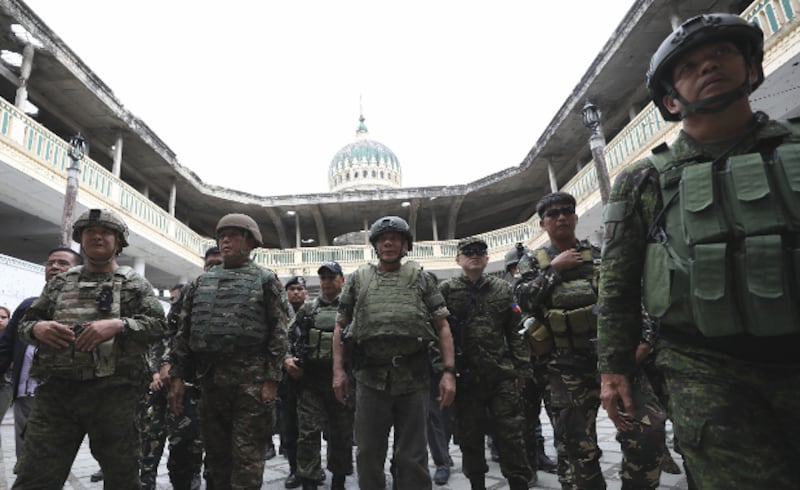Philippine troops killed at least five Islamic State-linked militants in a predawn firefight in Marawi on Tuesday, as military officials expressed confidence that they were within days of ending an almost four-month long siege in the southern city.
As the military struggled to clear an estimated few dozen militants, the United States said it had deployed one of its most advanced surveillance drones to help Philippine government forces end the battle in Marawi.
Military spokesman Col. Edgar Arevalo confirmed the five casualties, who battled Philippine marines despite repeated calls to surrender.
Troops recovered the bodies of two of the slain fighters, who were armed with high-caliber firearms and night-vision equipment, he said. But their three comrades were dragged away by the withdrawing militants before they set alight buildings to slow down the pursuing troops, he said.
The firefight followed President Rodrigo Duterte’s fourth visit to troops in Marawi that was aimed at boosting their morale. Monday’s trip came shortly after he paid his last respects to a Scout Ranger officer who was slain during the fighting for Marawi, the Philippines’ only Islamic city.
Photographs released by the presidential palace showed the president in non-regulation military fatigues over grey pants, and with a holstered semi-automatic pistol.
He appeared to be inspecting the Grand Mosque, a structure that had once served as the militants’ main stronghold before they were pushed out about two weeks ago.
His visit coincided with what military officials had described as the “final phase” of the operation to force the militants out of Marawi, a city of 200,000 residents that has been transformed into a moonscape by almost daily bombardments by government forces.
“The troops’ fighting spirit is further boosted because of the recent strong motivation and encouragement of the commander-in-chief,” Brig. Gen. Rolando Bautista, commander of the troops in Marawi, told reporters.
“The president’s recent presence in the main battle area has left a mark in our troops in their strong desire to end the crisis in Marawi,” he said.
Bautista said the military’s forward movement showed that the enemy force was “decreasing day-by-day” and that it was only a “matter of time that the crisis would end.”
The latest casualties brought to 660 the number of militants killed since the militants took over parts of Marawi, unleashing the biggest crisis to face the year-old administration of Duterte. Officials said 145 soldiers and 45 civilians had also died.
The fate of the militant leaders, including Abu Sayyaf leader Isnilon Hapilon, the acknowledged leader of the Islamic State in the region, remains largely unknown. But military officials said Hapilon could still be alive, backed up by several remaining fighters from the local Maute group and fighters from Southeast Asia and beyond.
The military had earlier said that at least 100 hostages were held by the group at the mosque and nearby buildings. It was not clear how many of the hostages remained under captivity as of Tuesday, although the military said that the female captives were forced to marry militants.
The U.S. Embassy in Manila, in a statement, said its state-of-the-art Gray Eagle Unmanned Aircraft Systems had a longer flight duration, which could help the Philippine military cover a larger area for surveillance.
The drone is capable of carrying infrared cameras, radar and missiles and can remain airborne for 25 hours. It will complement two counter-intelligence aircraft already handed over by U.S. authorities to Philippine forces.
Currently, small numbers of U.S. forces are engaged in intelligence work and are deployed in Marawi, but are barred from combat action unless attacked.
During the past three years, Washington, a longtime military ally of the Philippines, has provided Manila with 15 billion pesos ($295 million) for its intelligence-gathering upgrades.
“The strong, long-standing military relationship with the Philippines enables the U.S. to respond quickly to the (military’s) needs and to support,” its goals of modernizing its ranks, the U.S. Embassy said.

Philippine President Rodrigo Duterte (third from left) enters the Grand Mosque in the southern city of Marawi after it was retaken by government troops from control of Islamic State-linked militants, Sept. 11, 2017. [Presidential Communications/HO]
